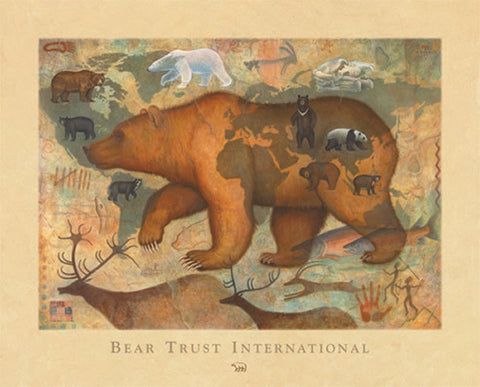Archived
All posters are now available exclusively from Frame of Mind. Please purchase posters on their website. All other artwork is available on this website.
This poster was commissioned by the Bear Trust International and is also available as a signed poster
Visiting with the Ancestors
By Monte Dolack
September 20, 2006
In the year 2000 at a time which coincided with my fiftieth birthday I received permission from the French Ministry of Culture to visit the Lascaux caves and view some of the oldest and the most celebrated Paleolithic paintings in the world. I had been informed that a limited number of official visits were granted each year and that this included scholars and artists. A visit to the caves represented an important personal quest to go back in time to the beginning of painting.
With the help of a neighbor who is a native of France and was a professor of French language at the University of Montana I was able to write a proper letter requesting permission for a visit to Lascaux for my wife Mary Beth Percival and me. We planned a trip around the possibility of a visit to the caves and hoped our request would be granted. Months went by and we had almost given up when we received an official document days before our departure informing us that we had been granted a “visiter exceptionnellement” and to be present at the gates to Lascaux, at 4pm on a certain day in late May.
We arrived at Lascaux early on a beautiful spring day. We located the gate and waited for the line up of people. We had heard that as many as 5 or 6 were allowed in at the same time even as hundreds visited Lascaux II, a reproduction constructed in 1983 and located nearby. We grew increasingly nervous as 4 pm approached and no one else showed up. At last a man and his dog walked over to the gate and asked us for our papers. As it turned out we were the only 2 people scheduled for that particular day.
For me the experience of spending less than an hour in the cave with our French guide Bruno Desplat one of the caretakers of Lascaux Cave was life changing. He was more than happy to be taking artists into his cave and shared our enthusiasm and wonder. The direct bond I felt with the artists who had made the pictures was extraordinarily personal, both intellectually and spiritually. As an American with emigrant ancestors from both Western and Central Europe, I felt an unusually deep connection to my own cultural and spiritual roots that I had never experienced before.
After visiting the caves it hit me that these were not “primitive” works but very sophisticated, beautiful and skillfully crafted paintings. There were dozens of pigments used in the creation of the paintings including rich blacks and blues, a range of yellow ochre, delicate pinks and many reds. An array of tools had been used to make these pictures including paint brushes, animal hide sponges and “crayons” of pigment held together with binders of animal fat. Some of the colors were from the cave itself and others from up to 25 miles away. As many as 30 different pigments were used by the artists and hand held flint tools found at the sight had been to incise the limestone walls. The paintings were rich with under laid incised marks that Bruno helped us to see by turning off the lights and holding his flashlight at an angle to illuminate hundreds of minute figures and engraved symbols. Bruno’s favorite English exclamative verb for what we all beheld was “Fantastic!” We agreed.
Located in the Dordogne area of Southwestern France the caves had been discovered by four boys and their dog in 1940. Fortunately one of the first people the boys told was a professor of anthropology. After the war Lascaux was opened to throngs of visitors and was an international sensation until being closed in 1963. The closure was due to contamination that had been brought in by the thousands of visitors who tramped through the cave almost daily. An alarming combination of humidity and carbon dioxide exhaled from visitors and the introduction of mold and lichen caused the closure. The paintings were in grave danger of being loved to death.
After the installation of an air conditioning system in 1968 and other precautions the Caves were reopened to very limited visits. This went on quite well until a new updated air conditioning system was installed weeks before our visit in the spring of 2000. The caves have been closed again after Bruno discovered a return of a white mold growing on the paintings in August of 2001. The new high tech air conditioning system proved to be a complete failure and actually promoted mold growth. It is unclear at this time whether the caves will ever be reopened.
Curiously the image of the Bear appears only once in Lascaux where there is a predominance of aurochs, bison, horses, red deer and felines. In nearby southeastern France the recently discovered and even older Chauvet Cave has a great many Bear paintings.
I began collecting bear images from all sources I could find. The Chauvet Cave bear images are among the oldest and most compelling. The published photographs of the Chauvet bear paintings proved most inspirational to me. The Chauvet caves remain closed to visitation but my experience at Lascaux gave an insight as to how they may appear.
My work had been influenced by ancient art, myth and cultural symbols prior to the visit but afterward the influence was far more pronounced and found it’s way into many recent and current paintings including Bears of the World, created for Bear Trust International and published as a fundraising and awareness poster.
The painting is rich in visual information, including a world map providing a backdrop for the powerful central image of a mythic cave bear. Each of the world’s eight bear species is portrayed, along with symbols and pictographs buried beneath layers of translucent paint that lend a sense of texture and unity. Besides being decorative and informational, I tried to make a painting with a visual dynamic that would be modern, historic and mythic.



